
The Trimurti is the trinity of supreme divinity in Hinduism, in which the cosmic functions of creation, preservation, and destruction are personified as a triad of deities. Typically, the designations are that of Brahma the creator, Vishnu the preserver, and Shiva the destroyer. The Om symbol of Hinduism is considered to have an allusion to Trimurti, where the A, U, and M phonemes of the word are considered to indicate creation, preservation and destruction, adding up to represent Brahman. The Tridevi is the trinity of goddess consorts for the Trimurti.

Hindu mythology is the body of myths attributed to, and espoused by, the adherents of the Hindu religion, found in Sanskrit texts such as the Vedic literature, epics like Mahabharata and Ramayana, the Puranas, and mythological stories specific to a particular ethnolinguistic group like the Tamil Periya Puranam and Divya Prabandham, and the Mangal Kavya of Bengal. Hindu myths are also found in widely translated popular texts such as the fables of the Panchatantra and the Hitopadesha, as well as in Southeast Asian texts.

Mahamaham, also known as Mahamagham or Mamangam, is a Hindu festival celebrated every 12 years in the Mahamaham tank located in the city of Kumbakonam in Tamil Nadu in the south of India. This 20-acre square tank surrounded by Shiva mandapams is believed by Tamil Hindus to be ancient, and the holy confluence of nine Indian river goddesses: Ganga, Yamuna, Sarasvati, Narmada, Godavari, Krishna, Tungabhadra, Kaveri, and Sarayu, states Diana Eck – a professor of Comparative Religion and Indian Studies. On the day of the Mahamaham festival, the river goddesses and Shiva gather here to rejuvenate their waters, according to a legend in the Periya Purana. The Hindus consider taking a pilgrimage and holy dip at the Mahamaham tirtha on the day of Mahamaham festival as sacred. The event attracts chariot processions, street fairs and classical dance performances in temple mandapas. The 12-year cycle Mahamaham festival in Tamil Nadu is observed in the Hindu calendar month of Magha, and is a symbolic equivalent of the Kumbh Mela.

Saraswati, also spelled as Sarasvati, is the Hindu goddess of knowledge, music, flowing water, abundance and wealth, art, speech, wisdom, and learning. She is one of the Tridevi, along with the goddesses Lakshmi and Parvati. She is a pan-Indian deity, also revered in Jainism and Buddhism.
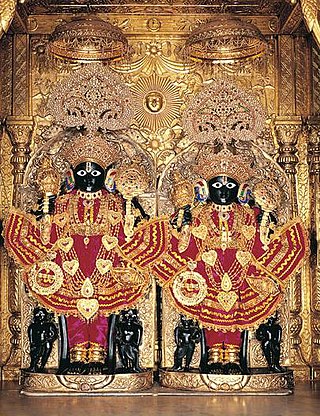
Naranarayana, also rendered Nara-Narayana, is a Hindu duo of sage-brothers. Generally regarded to be the partial-incarnation (aṃśa-avatara) of the preserver deity, Vishnu, on earth, Nara-Narayana are described to be the sons of Dharma and Ahimsa.

Himavat is the personification of the Himalayan mountains in Hinduism. He is the guardian deity of the Himalayas, and finds mention in the epic Mahabharata and other Hindu scriptures.
The following list consists of notable concepts that are derived from Hindu culture and associated cultures’ traditions, which are expressed as words in Sanskrit or other Indic languages and Dravidian languages. The main purpose of this list is to disambiguate multiple spellings, to make note of spellings no longer in use for these concepts, to define the concept in one or two lines, to make it easy for one to find and pin down specific concepts, and to provide a guide to unique concepts of Hinduism all in one place.
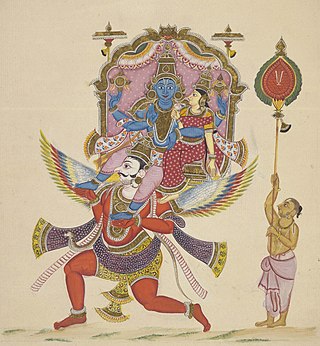
Lakshmi Narayana or Lakshmi Narayan is the dual representation of the Hindu deities Vishnu, also known as Narayana, and his consort, Lakshmi, traditionally featured in their abode, Vaikuntha. The goddess of prosperity and beauty, Lakshmi, is depicted as standing next to Vishnu, who holds the Panchajanya, Kaumodaki, Padma, and the Sudarshana Chakra. Another depiction of Lakshmi-Narayana portrays Lakshmi in the service of Narayana, who reclines on the cosmic serpent Shesha, floating in the Kshira Sagara, the Ocean of Milk.

Anasuya is an ascetic, and the wife of Sage Atri in Hinduism. She is the daughter of Devahuti and the Prajapati Kardama in Hindu texts. In the Ramayana, she lives with her husband in a small hermitage on the southern border of the Chitrakuta forest. A pious woman who leads an austere life, she is described as having miraculous powers.

Ganga is the personification of the river Ganges, who is worshipped by Hindus as the goddess of purification and forgiveness. Known by many names, Ganga is often depicted as a fair, beautiful woman, riding a divine crocodile-like creature called the makara.
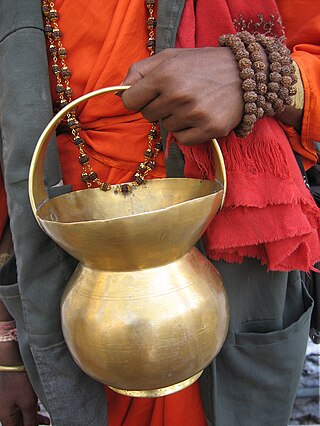
Kamandalu, kamandal, or kamandalam is an oblong water pot, originating from the Indian subcontinent, made of a dry gourd (pumpkin) or coconut shell, metal, wood of the Kamandalataru tree, or from clay, usually with a handle and sometimes with a spout. Hindu ascetics or yogis often use it for storing drinking water. The water-filled kamandalu, which is invariably carried by ascetics, is stated to represent a simple and self-contained life.

Devī is the Sanskrit word for 'goddess'; the masculine form is deva. Devi and deva mean 'heavenly, divine, anything of excellence', and are also gender-specific terms for a deity in Hinduism.

The Tridevi are a trinity of supreme divinity in Hinduism, joining a triad of eminent goddesses either as a feminine version of the Trimurti, or as consorts of a masculine Trimurti, depending on the denomination. This triad is typically personified by the Hindu goddesses Saraswati, Lakshmi, and Parvati. In Shaktism, these triune goddesses are the manifestations of Mula-Prakriti or Adi Parashakti.
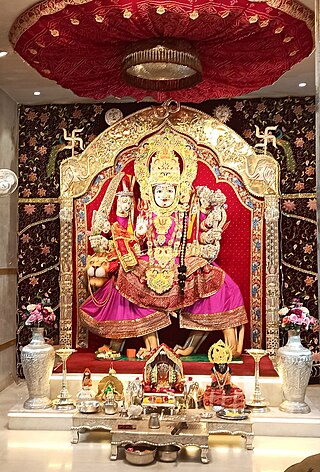
Yogamaya, also venerated as Vindhyavasini, Mahamaya, and Ekanamsha, is a Hindu goddess.
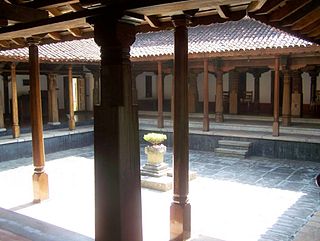
A Tulasi Vrindavana is a small podium-like stone or cement altar present in front of traditional Hindu houses, housing the sacred tulasi plant. Tulasi is an aromatic plant in the family Lamiaceae, native throughout the tropics, and widespread as a cultivated plant and an escaped weed.
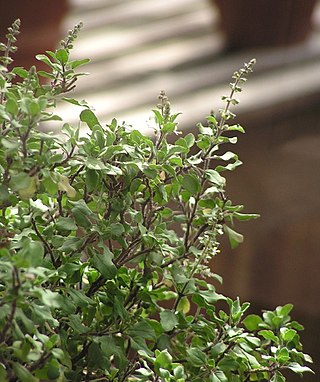
Tulasi, or Vrinda is a sacred plant in Hindu tradition. Hindus regard it as an earthly manifestation of the goddess Tulasi; she is regarded as the avatar of Lakshmi, and thus the consort of the god Vishnu. In another iteration, as Vrinda, she is married to Jalandhara. The offering of its leaves is recommended in ritualistic worship of Vishnu and his avatars, like Krishna and Vithoba.
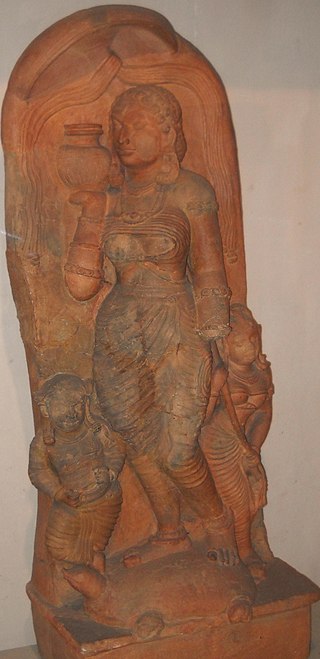
Yamuna is a sacred river in Hinduism and the main tributary of the Ganges River. The river is also worshipped as a Hindu goddess called Yamuna. Yamuna is known as Yami in early texts, while in later literature, she is called Kalindi. In Hindu scriptures, she is the daughter of Surya, the sun god, and Sanjna, the cloud goddess. She is also the twin sister of Yama, god of death. She is associated with the deity Krishna as one of his eight principal consorts, called the Ashtabharya. Yamuna plays an important role in Krishna's early life as a river. According to Hindu scriptures, bathing in or drinking Yamuna's waters removes sin.

Vadavagni, also referred to as Vadavanala refers to a submarine fire embodied in the form of a destructive being in Hindu mythology. It is described to be a being that manifested with the head of a mare, but a body of blazing flame.




















